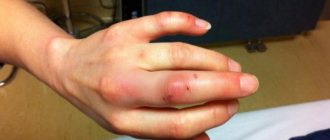The dangers of breaking a mercury thermometer and how to protect yourself
Thermometers have long become our good helpers. It’s probably difficult to find a person who doesn’t have a thermometer in their medicine cabinet. But few of us understand the principle of its operation, its design, or can clearly describe the operating rules, much less say what to do if the thermometer breaks. All we know is that there is mercury inside and it is dangerous. This means that the time has come to eliminate this annoying gap in knowledge about the objects that surround us in everyday life.
How to protect yourself when cleaning the thermometer?
If a mercury thermometer is damaged, it is important to thoroughly remove all mercury particles as soon as possible.
To protect yourself and others, you must take the following steps:
- All people and pets must be removed from the room, the door must be closed, and the windows must be opened to allow fresh air to enter.
- Shoe covers or plastic bags are put on your feet, rubber gloves are on your hands, and a respirator is used to protect your respiratory organs.
- You should wear work clothes that you won’t mind throwing away after cleaning.
- A damaged thermometer with residual mercury is placed in a glass container with water and the lid is tightly closed.
- Every 15 minutes there is a short break to get some fresh air.
After the procedure, the home is ventilated for 3 weeks. Surfaces on which mercury has been spilled are treated with disinfectants.
Important! When removing the consequences of a broken thermometer, you need to drink as much clean water as possible.
Chemical demercurization
- Preparation of physical solution. It is better to use potassium permanganate, bertholite salt. These are the most active sorbents against liquid poison. If they are not at home, then an aqueous or alcohol solution of iodine, soda ash, bleach. You need to work with bleach carefully so as not to damage the upper respiratory tract with chlorine vapor.
- Demercurization process. Pour the solution into each crack; you can also apply it to natural carpets, but not to carpets. The stains left behind will remain forever.
- Leave the solution for several hours, optimally a day.
- Carry out a wet cleaning of the room, removing all floor coverings and sending them to dry cleaning. Then carry out wet cleaning daily to minimize the concentration of metal vapors. The optimal ambient temperature is up to 15 degrees.
There are also industrial synthetic demercurization products. These are polymer esters, surfactants based on isobutylene, formaldehyde, butyl alcohol. The products are relatively cheap, and each drug comes with detailed instructions. Such mixtures cope well even with large contaminants, but they are toxic to others; precautions must be taken.
Mercury has long been considered a useful trace element that can cope with some skin pathologies. Modern cosmetics contain small amounts of this substance. The source of the element is also industrial waste, seafood products, and antifungal medications.
However, mercury intoxication often ends in disaster, especially for children. How to remove mercury from the human body?
Why can't you use a vacuum cleaner?
Before you start cleaning, you should clarify that using a vacuum cleaner in this case is strictly prohibited. Mercury beads, entering the motor of the device, cover all its elements with a film. Subsequently, each time the device is turned on, the engine will heat up, causing toxic fumes. Under the influence of hot air flow, toxins spread throughout the room.
If a vacuum cleaner was nevertheless used to remove mercury, the device will have to be disposed of, the sooner the better.
Safe ways to clean up mercury
There are several methods available that allow you to remove toxic substances from various surfaces. To do this, you will have to acquire the necessary accessories.
Collection Tools
Before removing mercury, prepare the following devices:
- Syringe.
- A couple of dampened paper sheets.
- Syringe.
- Patch.
- Cotton wool soaked in water.
- Scotch.
- Plasticine.
- A moistened shaving or painting brush.
After carrying out protective measures and preparing the instruments, you can proceed directly to the removal procedure.
Carpet cleaning
Small elements get lost in the pile, so getting them out is not so easy. A rubber bulb or syringe is suitable, which perfectly sucks up drops. Toxic particles are placed in a jar with a solution of potassium permanganate.
A sticky patch will also help remove mercury from the carpet. After cleaning is completed, all items, including clothing, are placed in a bag for mercury-containing waste.
The carpet is disinfected by spraying a solution of bleach or potassium permanganate. Such products can damage products, so they can be replaced with a more gentle composition. Dissolve 2 tablespoons of crushed laundry soap and 1 spoon of soda in a liter of warm water.
Cleaning from flat surfaces
The easiest way to clean smooth surfaces is laminate, linoleum, tile. You can remove mercury from a broken thermometer using either tape or paper. All spotted balls are collected onto sheets of paper and then placed in a jar of water. Small elements are collected with tape. Then the adhesive tape is sent to a previously prepared container.
The room is ventilated during the day, the place where the thermometer broke is wiped with a solution of potassium permanganate for a week, every day.
Cleaning wooden floors
Parquet and plank surfaces are cleaned using a syringe. The substance is absorbed and poured into the jar. Particular attention is paid to cracks. If necessary, the coating is illuminated with a flashlight; unnoticed balls will glow.
The place where the mercury got in is treated with potassium permanganate for a week. The room is regularly ventilated.
Cleaning upholstered furniture
It is very difficult to get rid of the consequences of a damaged thermometer on a sofa or bed. Mercury is quickly absorbed into the fabric. If measures are not taken in time, it will be impossible to get it out of there. The substance is collected with damp newspaper or hands, always wearing gloves.
After this, the room is ventilated, upholstered furniture is disinfected.
Further actions
After isolating the source of air pollution with mercury vapor, experts do not recommend rushing. Considering that mercury is a liquid, it actively adsorbs dust and dirt onto its surface. As a result, in just a few hours the volatility will decrease significantly. It is advisable to start demercurization one day after the spill, but if the room is residential and there are no other options, then you can start immediately.
Collect mercury:
- Calling specialists. Firefighters, industry specialists, and the sanitary and epidemiological station will help collect mercury. Typically, a few visits, up to 24 hours apart, are enough to completely clean up a mercury spill. This activity is licensed, therefore, you must first check the availability of the necessary permits. The presence of mercury vapor and its concentration is checked with a special device, which is verified annually.
- Carry out demercurization yourself using physical and chemical methods.
Necessary materials and tools for demercurization on your own:
- Special clothing: respirator, overalls;
- A small glass sealed jar for collecting mercury for further neutralization;
- Sealed bags for contaminated clothing;
- A syringe with a thick needle for collecting mercury;
- Cotton wool, bandage or thick tape;
- Gloves;
- Lamp;
- Sorbents (bleach, soda ash, bleach, potassium permanganate or iodine).
When collecting mercury, it is strictly forbidden to use a vacuum cleaner, broom or other methods that can break large balls into smaller ones. Then it will be more difficult to assemble the metal; you cannot do without special equipment.
What should you not do if the thermometer breaks?
It is important to remember the list of actions that are prohibited from performing when a thermometer breaks in the house:
- Do not clean with a vacuum cleaner or broom. The substance breaks down into smaller droplets and evaporates in the vacuum cleaner engine. As a result, such manipulations only complicate an already difficult situation.
- You should not machine wash items that have been in contact with liquid metal; even disinfectants will not help. Safe disposal of mercury is a complex procedure; regular washing will not replace it, but will make the equipment unsuitable for further use.
- Do not flush the substance down the sink or toilet. It still won’t reach the treatment plant, but will linger in the bends of the pipeline and will poison the air for many years.
The most important rule is not to panic. In this situation, emotions bring unnecessary problems.
Important! If you are confused and do not know what actions need to be taken, call the Ministry of Emergency Situations - 112. Qualified specialists will explain in detail what to do or send employees to eliminate the negative consequences.
What is strictly prohibited to do when neutralizing mercury at home?
- Under no circumstances should you collect mercury with a vacuum cleaner, no matter what modern model it is. The mercury will be dispersed inside the vacuum cleaner into tiny particles, and a running hot engine will increase evaporation many times over.
Important! After this treatment, the vacuum cleaner will have to be thrown away.
- Don't use a broom either. It will not help collect the balls, but will only crush and scatter them around the room.
- Collected mercury should not be poured down the drain. It will settle in the pipes and will poison the air in your home for a long time.
- Do not throw collected mercury into the garbage disposal. The jar may break, and the mercury will evaporate not in the landfill, as you expected, but in your entrance.
- Windows should not be opened until all the mercury has been collected. Wind blows or a draft will spread small balls of mercury throughout the room, which will poison your life for a long time and spoil your well-being.
- It is not recommended to turn on the air conditioner. In this case, mercury will settle on the filters.
What are the dangers of mercury-containing waste?
Liquid metal vapors lead to severe intoxication of the body.
This, in turn, provokes the development of severe pathologies:
- Nervous system disorders.
- Kidney diseases.
- Dermatological diseases.
- Decreased immunity.
- Deterioration of vision.
When inhaling toxins, a person will feel tired, nervous, and weak. Mercury is especially dangerous for pregnant women and developing fetuses, as well as for small children.
The effect of toxins is initially invisible. Over time, the poison accumulates in the body, causing deterioration in well-being and headaches, which cannot be relieved by conventional medications.
Hazard Class
Mercury is a poison with a “cumulative effect” and belongs to the first class of danger. The metal is in a liquid state at temperatures from -39 to +357 degrees. Already after the +18 mark, the substance begins to evaporate.
Does it heal or cripple?
More recently, in the 1970s, mercury was widely used in medicine. Thus, patients were prescribed the drug Mercuzal as a diuretic - it contained mercury ions. Mercury chloride was prescribed as a laxative along with castor oil; Many medicinal ointments contained mercuric cyanide. Dentists put mercury-containing fillings in people without hesitation.
And if you remember the ancient Indian yogis, they actually took a terrible drink, which included balls of mercury and sulfur. And they were sure that this contributed to longevity. The Chinese did not lag behind and also ate mercury - as part of the “immortality pills”.
In the 15th-16th centuries, it was customary to treat syphilis with mercury - which, alas, often led to mercury intoxication; The patient experienced hair loss, a sharp change in mental state, and even epileptic seizures.
Today, the toxic properties of mercury are well known, and pharmacists no longer include it in such quantities in medications. However, mercury is still included in vaccinations. There are different opinions about how bad it is; Thus, “anti-vaxxers” cite the mercury content in vaccines as their main argument.
Small amounts of mercury are found in sea water. It is no wonder that fish and other marine life are able to accumulate it in their bodies. It’s okay for them, but people who eat fish and seafood every day are under attack. This hardly concerns you and me - the average Russian eats fish two to three times a week, no more often. But the poor Colombians and Brazilians are suffering. According to studies by American scientists, tuna and lobster turned out to be especially “mercurial”. True, fishing companies publicly call such information horror stories. I wonder why?
en.wikipedia.org
How to properly dispose of mercury?
The substance is collected in a glass container, as described above, and all objects that have been in contact with it are collected in bags. Next, the waste must be handed over to a specialized institution for proper and safe disposal.
Can it be thrown in the trash?
It is strictly forbidden to throw away a damaged thermometer, including one in a tightly closed container, in garbage containers. Over time, the glass will break, and people nearby will be in danger. Mercury from one thermometer contaminates about 6,000 m³ of air.
What to do with a broken thermometer?
A damaged measuring instrument cannot simply be thrown away. It needs to be disposed of properly. You should report the incident to the Ministry of Emergency Situations; if necessary, they will come to your home.
In large cities there are demercurization services that quickly cope with the consequences of an unfortunate incident.
If you know how to properly remove mercury if a thermometer breaks, contact the nearest sanitary and epidemiological station. Experts will tell you where to donate the toxic substance.
Who should I contact?
It is better not to take risks and not collect mercury yourself. If trouble occurs, it is better to call either a special demercurization service or the Ministry of Emergency Situations. The main thing is that before calling, vacate the room and close it so that no one can break into it.
Demercurization and collection of mercury
The Ministry of Emergency Situations is an opportunity to get rid of mercury for free, but service employees cannot always arrive on time - sometimes you have to wait too long. Calling a demercurization service will be expensive, but specialists will arrive quickly. In addition, they will not only collect the mercury, but also, using special instruments, will try to find out whether harmful vapors remain in the air due to a ball of mercury that has rolled somewhere into a dark corner.
Rescuers collect mercury from the floor
On a note! The Ministry of Emergency Situations may refuse to respond to a call with a thermometer.
Previously it was said that ordinary cleaning products such as a broom and a vacuum cleaner should not be used to clean rooms from mercury. The latter is especially dangerous, since mercury will cover its insides with a thin film, heat up and, accordingly, evaporate faster, polluting the air. Vapors of the substance will come out of the vacuum cleaner along with the air flow and spread even further throughout the room. Also, do not re-wear or wash clothes that were worn by the person who removed the mercury. The substance can ruin not only your washing machine, but also your health. All clothes should be thrown away. All items used for cleaning, be it gloves, brushes or something else, are also thrown away.
Precautions when cleaning up mercury
It is also impossible to collect mercury with a rag - it (mercury) will rub into the floors and turn into such small balls that it will not be possible to collect them at all. Mercury should not be buried or burned, and when cleaning it, you should not use an air conditioner, if there is one in the house.
The thermometer is broken - what to do?
Reception points for mercury and waste containing it
Today, in Russian cities there are services for the collection of fluorescent light bulbs and other products that contain liquid metal. Reception points can be stationary or mobile. The latter are represented by containers with anti-vandal protection. Ecoboxes are often installed by management companies.
What to do if there is no collection point nearby?
Residents of villages and towns that do not have specialized reception centers must contact the district administration or SES. Employees of these institutions must explain what to do with a broken thermometer.
Strictly prohibited:
- Bury mercury-containing waste in the ground.
- Leave it under the trees.
- Dispose of with household waste.
You can find out the addresses of reception points by the number of the Ministry of Emergency Situations. The closed can will be accepted at the nearest emergency service.
Disposal and destruction of contaminated items
All things that have had contact with mercury should either be thrown away or at least ventilated. Moreover, it is recommended to keep them in the air for at least 3 months. After that, you can try to wash them and use them again.
The jar of mercury and the remains of the thermometer are handed over to the Ministry of Emergency Situations. Sometimes they can be sent from there to a management company or pharmacy, but still, only the Ministry of Emergency Situations or special services can resolve issues with the disposal of this heavy metal.
Disposal of a broken thermometer
Mercury Waste Management Law
There is a special Decree on standards for handling liquid metal. It states that only specialized companies can collect and accumulate mercury-containing waste separately from other waste.
Mercury should be stored in special premises, away from production facilities. Transportation is carried out using equipped transport, which prevents the release of toxins into the environment.
Important! All companies that dispose of liquid metal must have a license for this type of activity.
Eliminating the consequences of a broken thermometer is a serious task that needs a quick and competent solution. It is necessary to remove droplets from the surface of the floor, carpet or upholstered furniture as quickly as possible, act strictly according to the instructions, and use protective equipment. All waste is handed over to specialized collection points. After performing the manipulations, invite specialists to your home to check the room for the presence of mercury.
The thermometer broke, how and with what to collect mercury (2 videos)
Stages
First you need to collect the largest drops. They have a large surface bordering on air, therefore, a lot of vapor is formed. It is better to use thick paper and tape. As you move the sheet of paper, you can collect all the large drops, combine them into a single whole and pour the resulting mercury into a jar. It is better to collect small drops with a syringe, but be careful not to break them into small fragments. Scotch tape and adhesive plaster are excellent for such purposes. All available materials contaminated with metal must be placed in an airtight container and air access must be limited. To collect mercury in hard-to-reach places, it is better to use tampons soaked in potassium permanganate or bleach; they also need to be placed in a container.
If metal gets under the baseboard, behind the parquet, then dismantling is required.
It is strictly forbidden to throw mercury into landfills or trash bins - the degree of pollution will increase significantly. Every city has collection points for this liquid metal. If you throw poison down a garbage disposal, then the whole house can be poisoned, although in small concentrations.
Once all visible drops of metal have been collected, chemical demercurization can begin. The optimal solution is to make an aqueous solution of potassium permanganate, soda ash, iodine in proportions of 1:1:1.5 ml per 100 ml of water. You can also add vinegar and citric acid for greater effect. This solution is needed to disinfect small droplets that splash onto carpets. It is technically impossible to remove them in the usual way.











